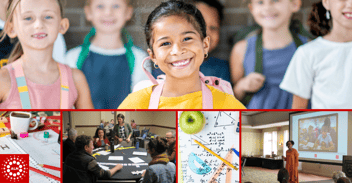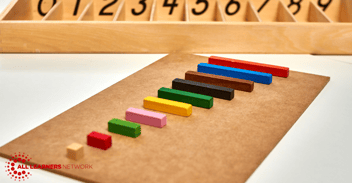
Unpacking Belonging in Math Class
Why is belonging in math class so important?
Feeling a sense of belonging is a vehicle to engagement. Engagement promotes both learning and empowerment as an expert learner. At All Learners Network (ALN), we believe in opening the doors to all learners, especially those who have historically struggled to learn math in traditional instructional design. Inclusion means all students are considered when designing instruction and providing access to grade level mathematics. Maslow (1943) posits five sets of goals, or basic needs, which are related to each other and are arranged in a hierarchy of importance. The third level of Maslow’s hierarchy of need reflects the importance of belonging- of human interaction where you are seen for your whole self. Maslow suggested that social belonging helps people to experience companionship and acceptance through family, friends, and other relationships (Maslow, 1943). When students see themselves represented and included in their math class, their need for social belonging is met and they are more positioned to engage and learn mathematics.
Katie Novak, a Universal Design for Learning (UDL) expert describes inclusive practice as ensuring all students have the opportunity to learn and be challenged based on their individual needs. Classroom routines and instruction must ensure every child is supported and challenged, regardless of student strengths and areas of need (Novak, 2022). Educators see and promote the variability of our learners and create an environment that allows students to use their understanding of themselves as expert learners to access what they need. Students are much more likely to engage in the learning that is happening when strong pedagogy and UDL give students the feeling of belonging. At ALN, we support teachers in creating, nurturing, and maintaining a cohesive class community where all students feel they are mathematicians who have the skills to communicate and contribute to the mathematical learning community.
When we emphasize our value that all means all, we mean every single child deserves a humanizing math experience. Gholdy Muhammad posits the idea of humanization as teaching in a way that sees the whole human through culturally and historically responsive teaching (2020). For math education to become more humanizing, we need to continue to focus our efforts on the individual needs of students. In education, we often neglect to consider that learning is part of the human condition and instead focus our conversations on standards and test scores and label students with unhelpful terms like “low kids” and “high kids.” Centering our instruction and classroom culture on students’ humanity is something both an individual teacher and a school system can control. At ALN, we believe we can do this by using students’ understanding of identity, specifically their math identity, along with strong pedagogy and knowledge of student strengths and areas to grow, to plan thoughtful learning opportunities that meet the actual humans in our room where they are.
What does it mean to belong in math class?
Recently, my 5 year old shared a classroom routine from his preschool class. Every morning during the Morning Meeting, they take attendance and sing a song about students who are absent that day. It goes something like “It’s sad when we miss two friends today, it’s sad when we miss two friends today.” They wish those students well and hope to see them the next day. My son shared this with me and then said, “So Mom, if I’m not here, my friends will think about me. They will be sad if I’m not there.” This simple daily routine sends the message “it matters that you are here” which is an essential component to feeling that you belong. Creating humanizing math experiences starts with considering the conditions for learning to make this happen. Belonging is a condition for learning and the precursor to accessing quality instruction.
On her podcast, Dare to Lead, Brené Brown interviewed Aiko Bethea, a Diversity, Equity and Inclusion expert. Brown and Bethea discuss their inclusivity work and the power of empathy and accountability. Their conversation was around leadership among adults, but it reminds us of the power dynamic between teachers and students in the math classroom. As teachers, when we show up for our students with empathy and make instructional choices that support access to grade level content through a Multi-Layered System of Support (MTSS), we send the message that we believe all students can learn. As educators that work with ALN, we believe it is our responsibility to create a space, both physically and emotionally, where students feel they are accepted and belong. When students feel that they belong, their engagement increases and they are more willing to take risks like participate in small group discussions, persevere through challenges, defend their thinking, reason through the thinking of others and make connections (Oyserman et al., 2006).
What does belonging require?
Katie Novak (2022) refers to an image that is widely used in educational settings. This image shows a few spectators (of varying heights) watching a baseball game with a fence blocking the view of the game. In the first image of the game, all spectators are given the same box to stand on in an attempt to see the game. This tool enables one spectator to see the game, while the other two are still unable to see over the fence. The metaphor reinforces the sentiment that equal does not meet everyone’s needs. In the second image of the game, all spectators are given the size box that allows them to see the game. The metaphor here reinforces equality- that everyone gets what they need. The final image shows the fence removed completely which is a metaphor for justice- all barriers to accessing the game are removed so supports are not needed to see the game. In this conversation, Novak explained that she doesn’t like this image, despite all barriers being removed to access, because what we are really looking for is for everyone to be able to actually play the game. Often in education, students are “integrated” into math class (we refer to this as Main Lesson)- or the lesson involving grade level content. In this situation, students are in the room, but are not often included in the learning. Every single child deserves affirming learning opportunities of grade level content in math. In order for students to engage in this type of learning, math must be made accessible to all students to promote the feeling of belonging, inclusion and affirming students’ identities.
Relationship building is the foundation for providing all students with a humanizing math experience that involves the feeling of belonging. Humans are instinctively wired for personal connection, especially with a caregiver (teacher) (Brown, 2015). Belonging requires trust. I trust you as a learner and you trust me to provide opportunities for you to choose from. I believe in you as a learner and represent you in the math we learn. Along with a belief in competence from both teacher to student and student to self, students must feel that they are valued in order to feel like they belong. They must feel like their voice is heard and that they have choice and autonomy based on their understanding of themselves as a learner. Belonging requires students to monitor and direct their own learning so they can work independently but safely ask for help when needed. When students feel that they belong, they are able to use their social-emotional skills to self-manage and self-regulate so their brain is available for learning (Shanker, 2017). Finally, belonging requires a self-reported sense of inclusion. Students must actively identify as part of the group. Students must feel that they are represented (Oyserman, et. al,. 2006). For students to gain this sense of inclusion, they must be part of a learning environment designed so all students can move safely throughout the room and access what they need (CAST, 2018). In order to achieve equity, inclusion, and justice- students need to feel like they belong. The barriers to belonging are removed and students are actively included in the learning. We don’t want kids to just WATCH the learning happening, but be engaged in it- don’t just watch the game, be PART of the play (Novak, 2022).
How do we achieve each of these elements of belonging?
The All Learners Network Lesson Structure including Launch, Main Lesson, Math Menu, and Closure supports access to grade level content for all, while creating a welcoming, inclusive environment supported by trusting relationships. Through the ALN Lesson structure, students are actively engaged and encouraged to participate in mathematical dialogue throughout the lesson. Students are supported in their ability to make sense of their thinking, reason through the thinking of others and justify their solution. Students are explicitly taught HOW to engage in math talk and supported in making choices that meet their individual needs. Following the ALN lesson structure helps to create an environment where students are seen as the individual human beings that they are.
Click here for the printable version.
What Now?
- The above blog post comes from chapter 6 of our book, Teaching Math for All Learners: Teaching educators to use effective strategies to help all children learn math. You can go here to read the whole book or just the rest of the chapter.
- Learn more about the All Learners Network Lesson Structure, a key tool in creating belonging in math class.
- Bring All Learners Network (ALN) into your school or district for embedded professional development.
References
Center for Applied Special Technology (CAST) (2018), Universal Design for Learning Guidelines version 2.2, Retrieved from http://udlguidelines.cast.org.
Maslow, A.H. (1943). A Theory of Human Motivation”. In Psychological Review, 50 (4), 430-437. Washington, DC: American Psychological Association.
Muhammad, G. (2020), Cultivating Genius: An Equity Framework for Culturally and Historically Responsive Literacy, Scholastic Teaching Resources (Teaching Strategies), Scholastic Teaching Resources (Teaching Strategies).
Novak, K. (2022), UDL Now!: A Teacher’s Guide to Applying Universal Design for Learning, CAST, Inc.; 3rd edition.
Oyserman, D., Brickman, D., Bybee, D., and Celious, A. (2006), Fitting in Matters: Markers of In-Group Belonging and Academic Outcomes, Institute for Social Research, The University of Michigan, Association for Psychological Science.
Shanker, S. (2017), Self-Reg: How to Help Your Child (and You) Break the Stress Cycle and Successfully Engage with Life, Penguin Books; Reprint edition.

All Learners Network is committed to a new type of math instruction. We focus on supporting pedagogy so that all students can access quality math instruction. We do this through our online platform, free resources, events, and embedded professional development. Learn more about how we work with schools and districts here.




